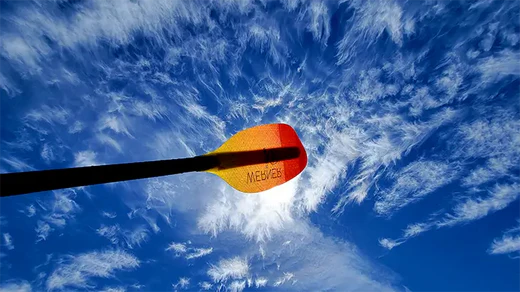How Many Calories Does Kayaking Burn?
August 21, 2023

Kayaking is a popular outdoor activity that offers recreational enjoyment and an effective workout. Beyond the picturesque views and serene waters, kayaking is a healthy way to exercise and burn calories outdoors in nature. Whether navigating calm lakes or tackling challenging rapids, kayaking can help you burn hundreds of calories and improve your overall fitness. In this article, we'll delve into how many calories kayaking can burn and the factors influencing this calorie-burning adventure. Let’s get right to it.
How many calories do you burn while kayaking?
On average, a person weighing around 155 pounds (70 kilograms) can expect to burn approximately 283 calories per hour of kayaking at a moderate pace. However, the number of calories burned while kayaking depends on various factors, such as your weight, intensity of activity, duration of the session, and the type of kayaking you're engaged in.
Factors Affecting Caloric Expenditure
- Intensity and Speed: The more effort you exert while paddling, the more calories you burn. Paddling leisurely will burn fewer calories compared to more intense and rapid strokes. Whitewater kayaking, which involves navigating through turbulent waters and navigating obstacles, can significantly increase calorie burn due to the heightened physical demands.
- Weight and Muscle Mass: Heavier individuals and those with greater muscle mass tend to burn more calories during kayaking because they require more energy to perform the same movements. Muscle mass contributes to a higher resting metabolic rate, which means that even when you're not actively paddling, you'll burn more calories at rest.
- Type & Size of Kayak: Also, inflatable kayaks are slightly slower in the water compared to hardshell kayaks, meaning they’ll require more energy to paddle and, thus, more calories burned. Just as your body weight will impact energy usage, the weight and size of your kayak will affect the number of calories burned, as heavier, longer kayaks require more energy to paddle.
- Duration: The longer you spend kayaking, the more calories you burn. Extended sessions, especially those over 60 minutes, can contribute to more significant overall caloric expenditure, especially if you maintain a consistent effort level.
- Water & Weather Conditions: Paddling against currents, wind, or rough waters requires more energy and leads to increased calorie burn. Choppy waters demand excellent stability and control, engaging more muscles. Also, if you wear additional layers like a wetsuit or a dry suit for kayaking, you’ll face more resistance, meaning more calories burned.
- Skill Level: Novices might expend more energy as they learn to paddle the kayak and navigate efficiently. With experience, skilled kayakers may become more efficient, which can affect calorie burn rates. However, advanced kayakers tend to burn more calories over time because of their time in the water.
- Number of Paddlers: If you’re paddling in a tandem kayak, you & your partner will split the calorie burn. Similarly, if you’re paddling in the middle or back of a group, you’ll likely draft off the paddlers ahead of you. Though marginal in most weather conditions, less wind resistance will make paddling more manageable, reducing the number of calories burned.
Health Benefits of Kayaking, Beyond Caloric Burn
While calorie burn is an essential aspect of any physical activity, kayaking offers several additional health benefits:
- Full-Body Workout: Kayaking engages various muscle groups, including the core, back, shoulders, arms, and legs. This comprehensive workout helps improve muscle strength, endurance, and overall toning.
- Cardiovascular Fitness: Kayaking at an intense pace can elevate your heart rate and enhance cardiovascular health. A stronger heart and improved circulation contribute to better overall fitness.
- Mental Well-Being: Being out in nature and on the water can have a calming and stress-reducing effect. Kayaking provides an opportunity to disconnect from the hustle and bustle of daily life, promoting mental well-being.
- Low Impact: Unlike high-impact activities like running, kayaking is gentler on the joints, making it suitable for individuals of various fitness levels and ages.
Kayaking is a recreational pursuit and a rewarding form of exercise that burns calories and offers numerous health benefits. The number of calories burned during kayaking varies depending on several factors, including intensity, duration, water conditions, and individual characteristics. Regardless of the numbers, the full-body workout and mental rejuvenation provided by kayaking make it an excellent choice for those seeking an engaging outdoor activity that contributes to overall fitness. So, next time you're contemplating a fun and active adventure, grab a kayak paddle for sale and hit the water to embark on a calorie-burning journey through nature's beauty.
Frequently Asked Questions
Is kayaking good exercise to lose weight?
Yes, kayaking is an excellent exercise for weight loss. It engages multiple muscle groups and burns 300 to 500 calories per hour, depending on intensity, making it a cardiovascular and strength-training activity.
Is kayaking better than going for a walk?
Kayaking is a low-impact, full-body workout that can improve strength, particularly in the upper body and core. At the same time, walking is more accessible, benefits leg strength and provides an excellent cardiovascular workout. Both activities have unique health benefits, making them complementary rather than competitive in a fitness regimen.
Does kayaking build muscle?
Yes, kayaking effectively builds muscle, targeting the upper body, core, and even the legs. It requires continuous paddling motion, which engages and strengthens these muscle groups over time. If done regularly, it provides a dynamic resistance workout that can enhance muscle tone and endurance.
How many calories do you burn while whitewater rafting?
The average person burns about 300 to 500 calories per hour while whitewater rafting, depending on the intensity of the rapids and the effort required to navigate them. Because of the upper body & core engagement needed to paddle and maintain balance, it’s one of the most calorie-intensive water activities.
How many calories do you burn while standup paddle boarding?
On average, standup paddle boarding burns between 400 to 500 calories per hour, with variations depending on the intensity of the activity and individual effort levels. This makes it an effective full-body workout that engages multiple muscle groups.

